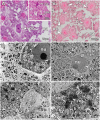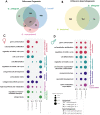The Molecular Machinery of Gametogenesis in Geodia Demosponges (Porifera): Evolutionary Origins of a Conserved Toolkit across Animals
- PMID: 32929503
- PMCID: PMC7743902
- DOI: 10.1093/molbev/msaa183
The Molecular Machinery of Gametogenesis in Geodia Demosponges (Porifera): Evolutionary Origins of a Conserved Toolkit across Animals
Abstract
All animals are capable of undergoing gametogenesis. The ability of forming haploid cells from diploid cells through meiosis and recombination appeared early in eukaryotes, whereas further gamete differentiation is mostly a metazoan signature. Morphologically, the gametogenic process presents many similarities across animal taxa, but little is known about its conservation at the molecular level. Porifera are the earliest divergent animals and therefore are an ideal phylum to understand evolution of the gametogenic toolkits. Although sponge gametogenesis is well known at the histological level, the molecular toolkits for gamete production are largely unknown. Our goal was to identify the genes and their expression levels which regulate oogenesis and spermatogenesis in five gonochoristic and oviparous species of the genus Geodia, using both RNAseq and proteomic analyses. In the early stages of both female and male gametogenesis, genes involved in germ cell fate and cell-renewal were upregulated. Then, molecular signals involved in retinoic acid pathway could trigger the meiotic processes. During later stages of oogenesis, female sponges expressed genes involved in cell growth, vitellogenesis, and extracellular matrix reassembly, which are conserved elements of oocyte maturation in Metazoa. Likewise, in spermatogenesis, genes regulating the whole meiotic cycle, chromatin compaction, and flagellum axoneme formation, that are common across Metazoa were overexpressed in the sponges. Finally, molecular signals possibly related to sperm capacitation were identified during late stages of spermatogenesis for the first time in Porifera. In conclusion, the activated molecular toolkit during gametogenesis in sponges was remarkably similar to that deployed during gametogenesis in vertebrates.
Keywords: Porifera; evolution; oogenesis; proteomics; spermatogenesis; transcriptomics.
© The Author(s) 2020. Published by Oxford University Press on behalf of the Society for Molecular Biology and Evolution.
Figures








Similar articles
-
The archaeal class Nitrososphaeria is a key component of the reproductive microbiome in sponges during gametogenesis.mBio. 2025 Jun 11;16(6):e0201924. doi: 10.1128/mbio.02019-24. Epub 2025 May 1. mBio. 2025. PMID: 40310091 Free PMC article.
-
Ultrastructure of oogenesis in two tropical oviparous Demospongiae (Porifera): Cinachyrella apion and Tethya maza.J Morphol. 2023 Sep;284(9):e21625. doi: 10.1002/jmor.21625. J Morphol. 2023. PMID: 37585226
-
Gametogenic processes and their relationship to normal and abnormal conceptus development.J Anim Sci. 1979;49 Suppl 2:1-25. doi: 10.1093/ansci/49.supplement_ii.1. J Anim Sci. 1979. PMID: 400775 Review.
-
Sex-biased gene expression precedes sexual dimorphism in the agonadal annelid Platynereis dumerilii.Development. 2025 Apr 1;152(7):dev204513. doi: 10.1242/dev.204513. Epub 2025 Apr 16. Development. 2025. PMID: 40067261
-
Endocrine regulation of gametogenesis in fish.Int J Dev Biol. 1994 Jun;38(2):217-29. Int J Dev Biol. 1994. PMID: 7981031 Review.
Cited by
-
Symbiont transmission in marine sponges: reproduction, development, and metamorphosis.BMC Biol. 2022 May 6;20(1):100. doi: 10.1186/s12915-022-01291-6. BMC Biol. 2022. PMID: 35524305 Free PMC article. Review.
-
Microbiome changes through the ontogeny of the marine sponge Crambe crambe.Environ Microbiome. 2024 Mar 11;19(1):15. doi: 10.1186/s40793-024-00556-7. Environ Microbiome. 2024. PMID: 38468324 Free PMC article.
-
Establishment of Host-Algal Endosymbioses: Genetic Response to Symbiont Versus Prey in a Sponge Host.Genome Biol Evol. 2021 Nov 5;13(11):evab252. doi: 10.1093/gbe/evab252. Genome Biol Evol. 2021. PMID: 34791195 Free PMC article.
-
Actinoporin-like Proteins Are Widely Distributed in the Phylum Porifera.Mar Drugs. 2022 Jan 15;20(1):74. doi: 10.3390/md20010074. Mar Drugs. 2022. PMID: 35049929 Free PMC article.
-
The Effects of Sampling and Storage Conditions on the Metabolite Profile of the Marine Sponge Geodia barretti.Front Chem. 2021 May 10;9:662659. doi: 10.3389/fchem.2021.662659. eCollection 2021. Front Chem. 2021. PMID: 34041223 Free PMC article.
References
-
- Abdo DA, Fromont J, McDonald JI.. 2008. Strategies, patterns and environmental cues for reproduction in two temperate haliclonid sponges. Aquat Biol. 1:291–302.
-
- Amiel A, Leclère L, Robert L, Chevalier S, Houliston E.. 2009. Conserved functions for Mos in eumetazoan oocyte maturation revealed by studies in a cnidarian. Curr Biol. 19(4):305–311. - PubMed
-
- Andrews S. 2010. FastQC: A Quality Control Tool for High Throughput Sequence Data [Online]. Available from:http://www.bioinformatics.babraham.ac.uk/projects/fastqc/.
-
- Aouacheria A, Geourjon C, Aghajari N, Navratil V, Deléage G, Lethias C, Exposito JY.. 2006. Insights into early extracellular matrix evolution: spongin short chain collagen-related proteins are homologous to basement membrane type IV collagens and form a novel family widely distributed in invertebrates. Mol Biol Evol. 23(12):2288–2302. - PubMed

